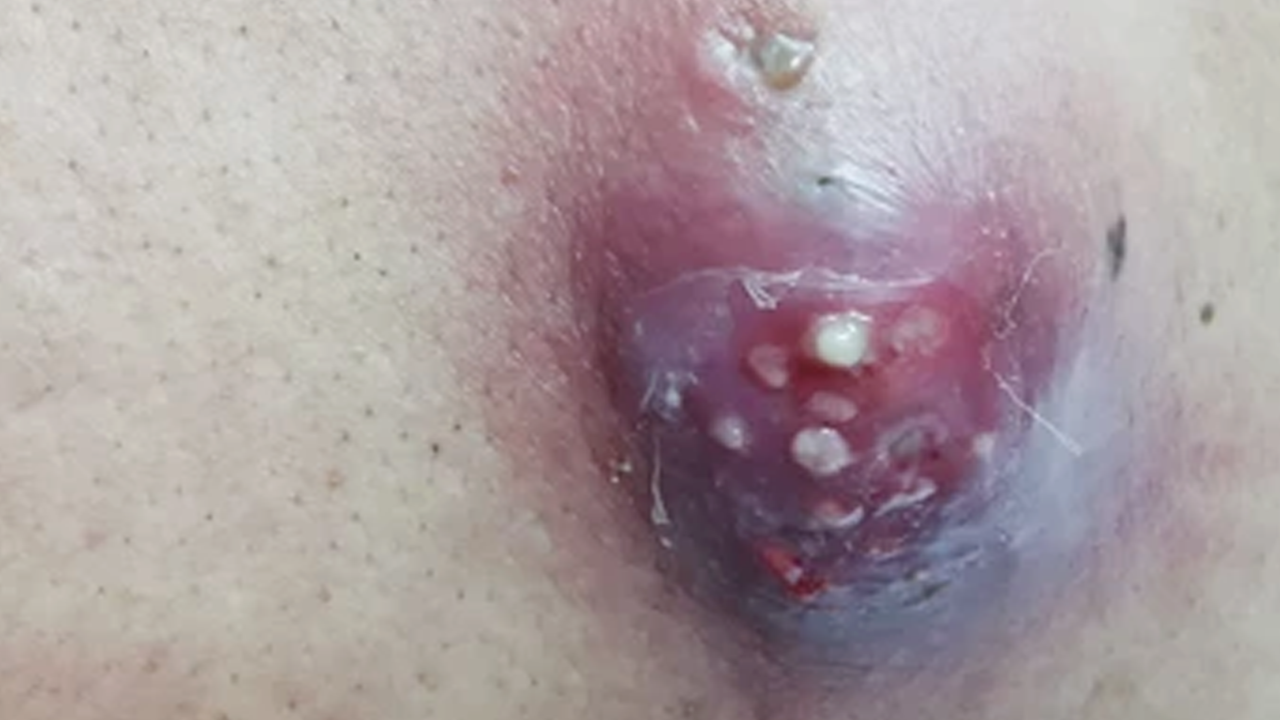Blackheads are a type of open comedone that occur when pores become clogged with excess oil, dead skin cells, and dirt. The dark color isn’t dirt but rather oxidation of the material inside the pore when it’s exposed to air. They frequently appear on the nose, chin, and forehead—areas where oil glands are most active. Regular exfoliation, salicylic acid products, and gentle extraction can help manage them.
Milia, on the other hand, are small, white, hard bumps that usually appear around the eyes, cheeks, or nose. Unlike blackheads, milia are not caused by clogged pores but rather by keratin trapped beneath the skin’s surface. They often require professional extraction using a sterile needle or lancet, as home removal can be difficult and lead to scarring.
Large nose acne and blackhead buildups can be particularly dramatic in extraction videos, drawing millions of viewers each week. These extractions, while satisfying to watch, are best performed by dermatologists or trained professionals to avoid skin damage or infection.
While pimple popping content continues to trend online, it’s important to remember that consistent skincare, hydration, and sun protection are key to preventing these issues in the first place. Using non-comedogenic products and maintaining a regular cleansing routine can go a long way in keeping skin clear and healthy.
🔹 1. Blackheads (Open Comedones)
What they are:
Blackheads are a type of acne that forms when a pore becomes clogged with dead skin cells and excess oil (sebum). The pore stays open, and the material inside oxidizes with air, turning black or dark brown.
Where they appear:
Commonly on the nose, forehead, and chin (T-zone), but they can occur anywhere.
Causes:
-
Excess oil production
-
Hormonal changes
-
Poor skincare habits
-
Use of comedogenic products
Treatment:
-
Topical retinoids (like adapalene)
-
Salicylic acid cleansers or toners
-
Clay masks to absorb oil
-
Extraction by a professional (not picking at home)
-
Consistent skincare routine to prevent buildup
🔹 2. Milia (Milium Cysts)
What they are:
Milia are tiny, white, hard bumps that form when keratin (a protein in skin) becomes trapped beneath the skin’s surface. They are not acne and have no inflammation or bacteria involved.
Where they appear:
Often around the eyes, cheeks, and nose.
Causes:
-
Skin trauma (like burns or blistering)
-
Heavy creams or oily skincare
-
Natural buildup of dead skin
-
Genetic predisposition
Treatment:
-
Usually resolve on their own over time
-
Exfoliation with gentle acids (AHA, BHA)
-
Retinoids (help with cell turnover)
-
Extraction by a dermatologist or licensed esthetician
🔹 3. Large Nose Acne (Inflamed Acne or Nodules on Nose)
What it is:
This refers to larger, red, sometimes painful pimples that can appear on the nose — often cystic or nodular acne. The nose has large sebaceous glands, making it prone to this type of acne.
Causes:
-
Hormonal imbalances
-
Bacterial buildup (especially Cutibacterium acnes)
-
Poor skincare habits or over-cleansing
-
Genetics
Treatment:
-
Benzoyl peroxide (targets bacteria)
-
Topical or oral retinoids
-
Antibiotics (topical or oral, depending on severity)
-
Isotretinoin for severe cases (prescribed by dermatologists)
-
Avoiding irritants (fragranced skincare, over-exfoliating)
🔍 How to Differentiate Them
| Feature | Blackheads | Milia | Large Nose Acne |
|---|---|---|---|
| Color | Black/dark surface | White/pearly | Red/inflamed |
| Size | Small, pinhead-sized | Tiny and firm | Medium to large |
| Pain | Painless | Painless | Can be painful |
| Inflammation | None | None | Present |
| Pore visibility | Open pore | No visible pore | Inflamed or blocked pore |
✅ Prevention Tips
-
Use non-comedogenic skincare products
-
Cleanse with a gentle, pH-balanced cleanser
-
Exfoliate 2–3 times/week with salicylic acid or glycolic acid
-
Avoid picking or squeezing lesions
-
See a dermatologist for persistent or severe issues
🔹 BLACKHEADS (Open Comedones)
✅ Best Treatments:
-
Salicylic Acid (BHA):
-
Exfoliates inside the pore and dissolves oil buildup
-
Use: 1–2% salicylic acid cleanser or toner (e.g., Paula’s Choice BHA Liquid)
-
-
Retinoids (Adapalene or Tretinoin):
-
Increase cell turnover and prevent clogged pores
-
OTC: Differin (Adapalene 0.1%)
-
RX: Tretinoin (stronger)
-
-
Clay Masks (1–2x/week):
-
Absorbs excess oil and tightens pores
-
Look for kaolin or bentonite clay
-
-
Professional Extraction:
-
Done by a licensed esthetician or dermatologist
-
Avoid self-extraction to prevent scarring
-
🔹 MILIA (Milium Cysts)
✅ Best Treatments:
-
Gentle Exfoliation:
-
Use AHAs (like glycolic or lactic acid) to remove surface skin cells
-
Avoid harsh scrubs — they won’t help
-
-
Topical Retinoids:
-
Helps prevent buildup of keratin under skin
-
Adapalene or tretinoin work well here too
-
-
Professional Removal:
-
Dermatologists use a sterile needle or lancet
-
Quick, painless, and reduces scarring
-
-
Avoid Heavy Creams:
-
Choose lightweight, non-comedogenic products
-
Especially avoid thick eye creams near milia-prone areas
-
🔹 LARGE NOSE ACNE (Inflamed or Cystic)
✅ Best Treatments:
-
Benzoyl Peroxide (2.5%–5%):
-
Kills acne-causing bacteria
-
Reduces inflammation
-
Use as a spot treatment or in a wash (e.g., PanOxyl)
-
-
Topical or Oral Antibiotics:
-
Clindamycin gel or oral doxycycline (by prescription)
-
For more severe or persistent breakouts
-
-
Retinoids:
-
As mentioned above, they reduce oil buildup and prevent clogged pores
-
-
Isotretinoin (Accutane):
-
A powerful oral medication for severe cystic acne
-
Requires a dermatologist and careful monitoring
-
-
Lifestyle Tips:
-
Avoid touching your face/nose
-
Keep pillowcases and phones clean
-
Avoid pore-clogging sunscreens (use non-comedogenic SPF)
-
🌿 Optional Natural Add-Ons (helpful, but not replacements for real treatment):
-
Tea tree oil (diluted): antibacterial
-
Aloe vera gel: calming for inflamed skin
-
Niacinamide: reduces oil and inflammation
